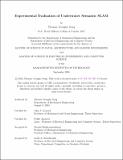Experimental Evaluation of Underwater Semantic SLAM
Author(s)
Song, Thomas Jeongho
DownloadThesis PDF (22.66Mb)
Advisor
Leonard, John J.
Agrawal, Pulkit
Terms of use
Metadata
Show full item recordAbstract
Autonomy is crucial for underwater vehicles due to the challenging and inaccessible nature of underwater environments. These environments pose significant difficulties for human-operated systems because of limited visibility, high pressure, and vast areas that are costly and risky to explore manually. Implementing autonomy in underwater vehicles presents unique challenges due to the marine environment's harsh and complex nature. Underwater communication is severely limited as water absorbs and scatters most electromagnetic signals used in terrestrial communications. This necessitates the use of acoustic communication, which has a lower bandwidth and is prone to delays and signal distortion. Similarly, GPS signals do not penetrate water, complicating navigation and creating dependence on inertial and sonar sensors, which suffer from noisy measurements that are guaranteed to drift over time. The unpredictable dynamics of underwater environments, including varying currents, lighting conditions and obstacles, further complicate autonomous navigation. As such, data collection while moving through a preplanned course is the traditional mission of the Autonomous Underwater Vehicle (AUV), defining the limitation of current technology. Higher-level missions such as search, surveillance, maintenance and manipulation require greater situational awareness, decision-making and navigation abilities, facilitated by processing semantic visual information and applying it to map generation and localization. To address the limited autonomy of current AUVs and enhance their capability for complex missions, this thesis presents the development and evaluation of a real-time, monocular visual-inertial semantic Simultaneous Localization and Mapping (SLAM) system for underwater environments, implemented on the cost-effective BlueROV2 platform. The research aims to enhance AUV autonomy and enable complex underwater missions through improved navigation and semantic mapping capabilities. Key contributions include the integration of a custom-trained object detector for underwater environments, adaptation of a hybrid SLAM algorithm combining Gaussian and Non-Gaussian landmarks for underwater operation, preliminary assessment of the SLAM system's accuracy using motion capture-based ground truth measurements, and comparative evaluation of the developed semantic SLAM system against state-of-the-art alternatives in an indoor pool experiment using the BlueROV2. This work addresses the challenges of underwater navigation and semantic mapping, offering a potential solution to extend the operational capabilities and mission complexity of affordable AUV platforms.
Date issued
2024-09Department
Massachusetts Institute of Technology. Department of Electrical Engineering and Computer Science; Massachusetts Institute of Technology. Department of Mechanical EngineeringPublisher
Massachusetts Institute of Technology